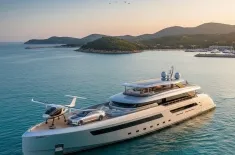Explore how luxury hospitality is redefining fine dining with responsible sourcing, ethical supply chains.
The world of luxury hospitality dining is undergoing a profound transformation. For decades, opulence was defined by extravagance, exotic ingredients flown in from distant lands, and a relentless pursuit of the rarest delicacies. Today, a new, more meaningful metric for luxury has emerged: integrity, transparency, and sustainability. The modern gourmet is no longer just interested in what is on the plate, but how it got there. This shift elevates Responsible sourcing from a niche trend to a fundamental pillar of high-end cuisine, linking culinary excellence directly to environmental stewardship and social equity.
The Foundation of Integrity: Hyper-Local, Traceable Ingredients
At the heart of the luxury dining evolution is a radical commitment to ingredient quality and provenance. High-end restaurants are moving away from complex, long-distance supply chains to prioritize hyper-local sourcing. This is more than a preference; it is a strategic business and ethical imperative that allows chefs to exert a level of control and ensure freshness that global supply lines simply cannot match.
Redefining Local Provenance
The term local provenance has been redefined in this context. It doesn't just mean "from the region"; it signifies a deep, personal relationship between the chef and the producer. Many luxury hotels and restaurants are now cultivating their own on-site gardens, greenhouses, or even working directly with a single farm, creating a micro-ecosystem of supply.
- Farm-to-Table, Elevated: This approach maximizes the nutrient density and flavor profile of the food, as ingredients are often harvested mere hours before being served. The narrative of the dish becomes a direct story of the land and the farmer, which significantly enhances the guest's experiential dining.
- Traceability and Transparency: Modern luxury demands traceability. Guests are increasingly educated and want to know the exact source of their meal. Blockchain technology and advanced digital tracking are being deployed to verify the origin of high-value items, offering an unprecedented level of transparency that builds consumer trust. Knowing the specific farm, the cultivation methods, and the environmental impact of a product is now a key selling point.
The Ethical Imperative: Ethical Supply Chain
Ethical supply chain management goes far beyond environmental concerns; it addresses the social dimension of sustainability. For luxury establishments, this means ensuring fair labor practices, safe working conditions, and equitable pay for all workers, from farmhands to fishermen, particularly in developing countries where exotic ingredients might be sourced.
- Fair Trade and Labor: Luxury brands are auditing their suppliers to ensure compliance with international labor standards, rejecting commodities associated with exploitation or human rights abuses. This is especially crucial for products like coffee, chocolate, vanilla, and certain spices that are often plagued by complex, opaque supply chains.
- Socio-Economic Impact: By paying a premium for ethically sourced ingredients, high-end restaurants not only guarantee superior quality but also directly support the economic stability of small-scale producers and farming communities. This circular economy model is the ultimate expression of modern, conscious luxury.
Mitigating Environmental Impact: From Ocean to Plate
The impact of high-end dining on natural resources, particularly the oceans, has become a major focus for Responsible sourcing. The unsustainable harvesting of marine life is a critical global issue, and luxury hospitality is leading the charge in implementing change.
Sustainable Seafood Practices
The commitment to sustainable seafood requires chefs to become conservationists, carefully curating their menus to exclude species that are overfished or harvested using destructive methods.
- Certification and Guidance: Restaurants are relying on organizations like the Monterey Bay Aquarium’s Seafood Watch program or certifications from the Marine Stewardship Council (MSC) and Aquaculture Stewardship Council (ASC) to guide their purchasing decisions.
- Diversification of Menus: Instead of focusing on a few popular, high-demand species (like Bluefin Tuna or Chilean Sea Bass), chefs are embracing lesser-known, locally abundant, and sustainably managed fish. This culinary creativity not only protects vulnerable populations but also introduces guests to novel textures and flavors, turning an ethical choice into a gastronomic adventure.
- Responsible Aquaculture: For farmed fish, the focus is on recirculating aquaculture systems (RAS) and other closed-loop systems that minimize pollution and the use of unsustainable feed, ensuring that "farm-raised" is synonymous with "sustainable."
Culinary Innovation: Zero-Waste and Plant-Forward Gastronomy
The new luxury fine dining scene is characterized by a commitment to eliminating food waste and a revolutionary embrace of vegetables. These movements, driven by both ethical and creative motives, are transforming the very structure of the menu.
The Zero-Waste Dining Revolution
The concept of zero-waste dining is the pinnacle of kitchen efficiency and creativity. It is the philosophy that no ingredient—from carrot tops to fish bones—should be discarded without extracting its full flavor and value.
- Root-to-Stem and Nose-to-Tail: Chefs are demonstrating incredible ingenuity by utilizing every part of the ingredient. Vegetable trimmings are fermented into complex sauces, infused into oils, or dehydrated into powders. Fish bones become rich stock, and forgotten cuts of meat are cured or braised into delectable features.
- Composting and Energy Conversion: For the unavoidable leftovers (like plate scrapings), leading establishments implement on-site composting systems that return nutrients to partner farms, or utilize advanced food waste digestors to convert scraps into renewable energy. This closed-loop system is the ultimate expression of responsibility.
- Optimized Operations: The zero-waste ethos necessitates meticulous planning, smart inventory management, and seasonal menu engineering to avoid overstocking and spoilage. This operational efficiency not only aligns with sustainability goals but also positively impacts the restaurant’s bottom line, proving that ethical practice can be economically viable.
Embracing Plant-Forward Luxury
The rise of plant-forward luxury represents a monumental shift in haute cuisine. Meat and fish are no longer the automatic centerpiece; instead, they serve as optional accompaniments or are entirely absent from the plate, giving the spotlight to vegetables.
- Vegetable as the Star: Chefs are applying techniques traditionally reserved for meat—fermentation, smoking, aging, and molecular gastronomy—to humble vegetables. A roasted, glazed celeriac can be as luxurious and complex as a prized piece of Wagyu beef.
- Health and Wellness: This trend aligns perfectly with the growing consumer demand for lighter, healthier, and more functional dining experiences, positioning the luxury meal not as an indulgence to be recovered from, but as a source of nourishment and well-being.
- Creative Freedom: The limitations of an animal-centric menu are replaced by the boundless potential of the plant kingdom, sparking a new era of innovation in flavor, texture, and presentation that redefines what a high-end meal can be.
Conclusion: Excellence Through Accountability
The future of high-end dining is inherently tied to accountability. Responsible sourcing is not a passing fad; it is the new benchmark for excellence, demanding that every ingredient on the plate not only tastes spectacular but also tells a positive story—a story of local support, ethical supply chain integrity, ocean health through sustainable seafood, minimal environmental impact via zero-waste dining, and culinary innovation with plant-forward luxury.
By prioritizing hyper-local, traceable, and ethically sourced ingredients and committing to eliminating food waste, high-end restaurants are not just serving meals; they are curating a conscious, deeply meaningful experience. They are leveraging their influence to drive global change, proving that the truest form of luxury today is one that nourishes the guest, supports the producer, and respects the planet. This elevated standard sets a powerful example for the entire hospitality industry, solidifying the idea that a world-class dish must first and foremost be a world-responsible dish.



































